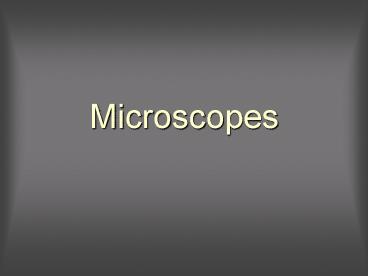Microscopes - PowerPoint PPT Presentation
1 / 10
Title: Microscopes
1
Microscopes
2
The Compound Microscope
- A compound Microscope is the type of microscope
that most people think of when they hear the word
Microscope. - It uses two lenses to focus the light that is
passing through a sample.
3
Magnification vs. Resolution
- Magnification
- Is how large an image can be made.
- Resolution
- Is how clear an image can be made.
4
- Robert Hooke made several improvements to the
first compound microscopes. - While he was looking at slices of cork under the
microscope, he called the little rectangles
Cells because it reminded him of the way cells
in a prison are arranged.
5
Anton van Leeuwenhoek
- Leeuwenhoek was an amateur scientist who made his
own lenses for his microscope. - He looked at pond water and called many of the
things he saw Animalcules. - Animalcules means little animals.
6
Parts of the Scope
- Eye piece
- The eye piece is what you observe items through.
- This eye piece magnifies objects by 10 times
(10x) - Body Tube
- Neck/Arm
- This is where one of your two hands holds the
scope while you are moving it.
7
Parts of the Scope
- Revolving nose piece
- Turns to allow you to change magnification.
- Stage Clip
- Holds microscope slides in place while being
observed. - Objectives
- The other lenses of a Compound Microscope
- 4x, 10x and 40x
- Total magnification eyepiece x objective.
- Current magnification 40x
8
Parts of the Scope
- Stage Stop
- Keeps the stage from moving too high.
- Microscope slide
- Stage
- This is where the microscope slide is placed to
observe specimen - Course Adjustment Knob
- Used at first to bring a specimen into position.
- Must be used on low power only
9
Parts of the Scope
- Diaphragm
- Has small holes in it to allow different amounts
of light through to help view a specimen. - Light Source
- Can be a mirror to reflect light or an electric
light source. - Fine Adjustment knob
- Used on medium and high power to bring the image
of a specimen into focus. - Light Switch
- Turn on/off power.
- When not in use, turn off
- Base
- Provides support for the microscope.
10
- http//www.microscopy-uk.org.uk/mag/indexmag.html?
http//www.microscopy-uk.org.uk/mag/wimsmall/sundr
.html - http//www.gpmatthews.nildram.co.uk/animalcules/































